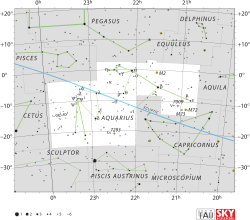88 Aquarii

| |
| Observation data Epoch J2000.0 Equinox J2000.0 | |
|---|---|
| Constellation | Aquarius |
| Right ascension | 23h 09m 26.79681s[1] |
| Declination | –21° 10′ 20.6812″[1] |
| Apparent magnitude (V) | +3.679[2] |
| Characteristics | |
| Spectral type | K1 III[3] |
| U−B color index | +1.239[2] |
| B−V color index | +1.215[2] |
| Astrometry | |
| Radial velocity (Rv) | +21.1[4] km/s |
| Proper motion (μ) | RA: +55.40[1] mas/yr Dec.: +30.49[1] mas/yr |
| Parallax (π) | 12.05 ± 0.22[1] mas |
| Distance | 271 ± 5 ly (83 ± 2 pc) |
| Details | |
| Radius | 29[5] R☉ |
| Surface gravity (log g) | 2.34[6] cgs |
| Temperature | 4,430[6] K |
| Metallicity [Fe/H] | –0.24[6] dex |
| Other designations | |
88 Aquarii (abbreviated 88 Aqr) is a star in the equatorial constellation of Aquarius. 88 Aquarii is the Flamsteed designation though it also bears the Bayer designation c2 Aquarii. In dark conditions it is visible to the naked eye with an apparent visual magnitude of +3.68.[2] Based upon parallax measurements, this star is at a distance of around 271 light-years (83 parsecs) from Earth.[1]
The spectrum of 88 Aquarii matches an evolved giant star with a classification of K1 III.[3] Its measured angular diameter is 3.24 ± 0.20 mas,[8] which, at the estimated distance of Delta Ophiuchi,[1] yields a physical size of about 29 times the radius of the Sun.[5] The cool, orange hued glow of this star comes from the outer atmosphere's effective temperature of 4,430 K.[6]
References
- 1 2 3 4 5 6 7 van Leeuwen, F. (November 2007), "Validation of the new Hipparcos reduction", Astronomy and Astrophysics, 474 (2): 653–664, arXiv:0708.1752
 , Bibcode:2007A&A...474..653V, doi:10.1051/0004-6361:20078357.
, Bibcode:2007A&A...474..653V, doi:10.1051/0004-6361:20078357. - 1 2 3 4 Gutierrez-Moreno, Adelina; et al. (1966), A System of photometric standards, 1, Publicaciones Universidad de Chile, Department de Astronomy, pp. 1–17, Bibcode:1966PDAUC...1....1G.
- 1 2 Houk, Nancy (1978), Michigan catalogue of two-dimensional spectral types for the HD stars, 4, Ann Arbor: Dept. of Astronomy, University of Michigan, Bibcode:1988mcts.book.....H.
- ↑ Wielen, R.; et al. (1999), Sixth Catalogue of Fundamental Stars (FK6). Part I. Basic fundamental stars with direct solutions (35), Astronomisches Rechen-Institut Heidelberg, Bibcode:1999VeARI..35....1W.
- 1 2 Lang, Kenneth R. (2006), Astrophysical formulae, Astronomy and astrophysics library, 1 (3rd ed.), Birkhäuser, ISBN 3-540-29692-1. The radius (R*) is given by:
- 1 2 3 4 McWilliam, Andrew (December 1990), "High-resolution spectroscopic survey of 671 GK giants. I - Stellar atmosphere parameters and abundances", Astrophysical Journal Supplement Series, 74: 1075–1128, Bibcode:1990ApJS...74.1075M, doi:10.1086/191527.
- ↑ "88 Aqr -- Star", SIMBAD Astronomical Object Database, Centre de Données astronomiques de Strasbourg, retrieved 2012-07-13
- ↑ Richichi, A.; Percheron, I.; Khristoforova, M. (February 2005), "CHARM2: An updated Catalog of High Angular Resolution Measurements", Astronomy and Astrophysics, 431: 773–777, Bibcode:2005A&A...431..773R, doi:10.1051/0004-6361:20042039